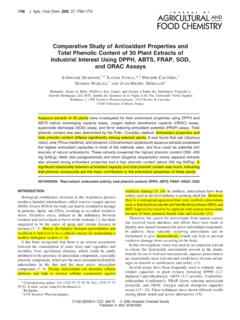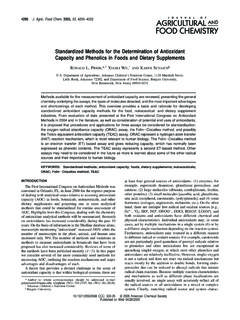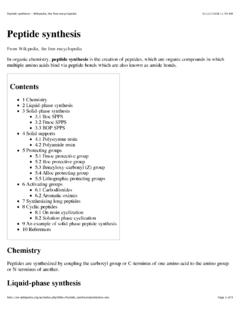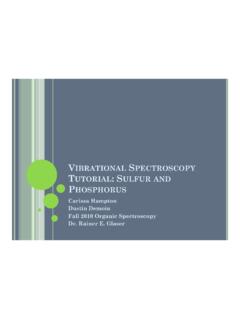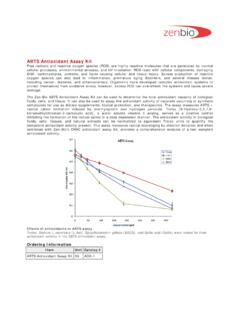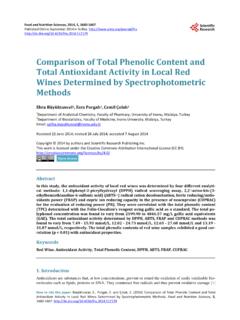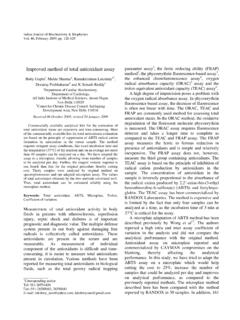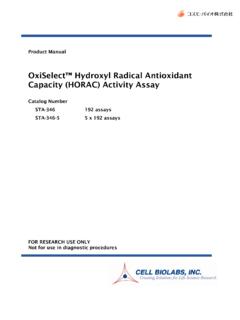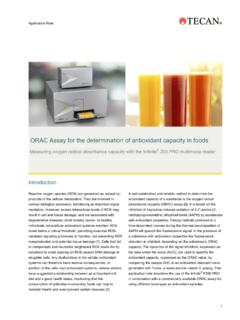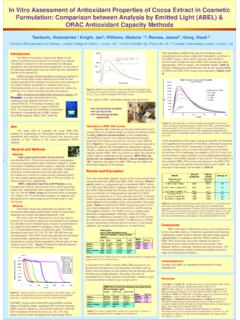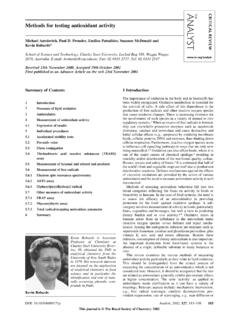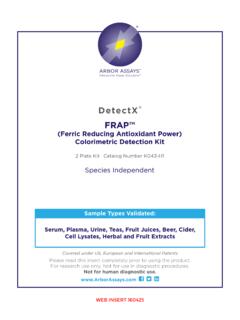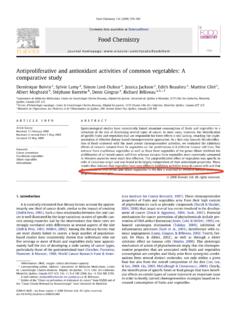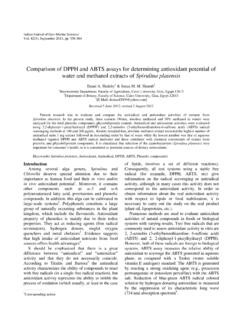Transcription of Standardized Methods for the Determination of Antioxidant ...
1 Standardized Methods for the Determination of AntioxidantCapacity and Phenolics in Foods and Dietary SupplementsRONALDL. PRIOR,*, XIANLIWU, ANDKARENSCHAICH Department of Agriculture, Arkansas Children s Nutrition Center, 1120 Marshall Street,Little Rock, Arkansas 72202, and Department of Food Science, Rutgers University,New Brunswick, New Jersey 08903-0231 Methods available for the measurement of Antioxidant capacity are reviewed, presenting the generalchemistry underlying the assays, the types of molecules detected, and the most important advantagesand shortcomings of each method. This overview provides a basis and rationale for developingstandardized Antioxidant capacity Methods for the food, nutraceutical, and dietary supplementindustries. From evaluation of data presented at the First International Congress on AntioxidantMethods in 2004 and in the literature, as well as consideration of potential end uses of antioxidants ,it is proposed that procedures and applications for three assays be considered for standardization:the oxygen radical absorbance capacity (ORAC) assay, the Folin-Ciocalteu method, and possiblythe Trolox equivalent Antioxidant capacity (TEAC) assay.
2 ORAC represent a hydrogen atom transfer(HAT) reaction mechanism, which is most relevant to human biology. The Folin-Ciocalteu methodis an electron transfer (ET) based assay and gives reducing capacity , which has normally beenexpressed as phenolic contents. The TEAC assay represents a second ET-based method. Otherassays may need to be considered in the future as more is learned about some of the other radicalsources and their importance to human : Standardized Methods ; Antioxidant capacity ; foods, dietary supplements; nutraceuticals;ORAC; Folin-Ciocalteu method; TEACINTRODUCTIONThe First International Congress on Antioxidant Methods wasconvened in Orlando, FL, in June 2004 for the express purposeof dealing with analytical issues relative to assessing antioxidantcapacity (AOC) in foods, botanicals, nutraceuticals, and otherdietary supplements and proposing one or more analyticalmethods that could be Standardized for routine assessment ofAOC.
3 Highlights from this Congress, dealing with the chemistryof Antioxidant analytical Methods will be summarized. Researchon antioxidants has increased considerably during the past 10years. On the basis of information in the Medline database alone,manuscripts mentioning Antioxidant increased 340% while thenumber of manuscripts in the plant, animal, and human areaincreased only 39%.The number of Methods and variations inmethods to measure antioxidants in botanicals that have beenproposed has also increased considerably. Reviews of some ofthe Methods have been published recently (1-5). In this paperwe consider several of the more commonly used Methods formeasuring AOC, outlining the reaction mechanisms and majoradvantages and disadvantages of factor that provides a distinct challenge in the assay ofantioxidant capacity is that within biological systems, there areat least four general sources of antioxidants : (1) enzymes, forexample, superoxide dismutase, glutathione peroxidase, andcatalase; (2) large molecules (albumin, ceruloplasmin, ferritin,other proteins); (3) small molecules [ascorbic acid, glutathione,uric acid, tocopherol, carotenoids, (poly)phenols]; and (4) somehormones (estrogen, angiotensin, melatonin, etc.)
4 On the otherhand, there are multiple free radical and oxidant sources [ ,O2 -,1O2,HO ,NO , ONOO-, HOCl, RO(O) , LO(O) ], andboth oxidants and antioxidants have different chemical andphysical characteristics. Individual antioxidants may, in somecases, act by multiple mechanisms in a single system (6)orbya different single mechanism depending on the reaction , antioxidants may respond in a different mannerto different radical or oxidant sources. For example, carotenoidsare not particularly good quenchers of peroxyl radicals relativeto phenolics and other antioxidants but are exceptional inquenching singlet oxygen, at which most other phenolics andantioxidants are relatively ineffective. However, singlet oxygenis not a radical and does not react via radical mechanisms butreacts mostly by the addition to double bonds, forming endo-peroxides that can be reduced to alkoxyl radicals that initiateradical chain reactions.
5 Because multiple reaction characteristicsand mechanisms as well as different phase localizations areusually involved, no single assay will accurately reflect all ofthe radical sources or all antioxidants in a mixed or complexsystem. Clearly, matching radical source and system charac-* Author to whom correspondence should be addressed telephone (501) 354-2747; fax (501) 364-2818]. Arkansas Children s Nutrition Center. Rutgers Agric. Food ,53,4290 CCC: $ 2005 American Chemical SocietyPublished on Web 04/26/2005teristics to Antioxidant reaction mechanisms is critical in theselection of appropriate AOC assay Methods , as is considerationof the end use of the results. It must be appreciated at the outsetthat there is no simple universal method by which AOC can bemeasured accurately and Do We Need a Standardized AOC Method?Althoughit may seem intuitive, one might question why we needstandardized analytical Methods of AOC.
6 Agreement on stan-dardized test Methods allows for (1) guidance for appropriateapplication of assays, (2) meaningful comparisons of foods orcommercial products, (3) a means to control variation withinor between products, and (4) provision of quality standards forregulatory issues and health claims. Too many analyticalmethods result in inconsistent results, inappropriate applicationand interpretation of assays, and improper specification of some agreement on standards for quantities and units,marketing of botanicals and associated trade becomes haphazard,science becomes unscientific , and technological developmentof nutraceuticals is for Consideration in Method Selection the selection of any method for standardiza-tion, a first consideration is that the method has been used fora sufficient amount of time and in a number of differentlaboratories such that the strengths and weaknesses of the assayhave become apparent and some time has been spent in dealingwith these issues.
7 This is not to say that newer Methods maynot potentially be as good or better, but use over time willgenerally point this out. A Standardized method for AOC shouldmeet the following ideal requirements: (1) measures chem-istry actually occurring in potential application(s); (2) utilizesa biologically relevant radical source; (3) simple; (4) uses amethod with a defined endpoint and chemical mechanism; (5)instrumentation is readily available; (6) good within-run andbetween-day reproducibility; (7) adaptable for assay of bothhydrophilic and lipophilic antioxidants and use of differentradical sources; (8) adaptable to high-throughput analysis forroutine quality control characteristics that should be considered in thestandardization of an assay include (a) analytical range, (b)recovery, (c) repeatability, (d) reproducibility, and (e) recogni-tion of interfering MECHANISMSD ifferentiation between Hydrogen Atom Transfer (HAT)and Single Electron Transfer (SET).
8 antioxidants can deac-tivate radicals by two major mechanisms, HAT and SET. Theend result is the same, regardless of mechanism, but kineticsand potential for side reactions differ. Proton-coupled electrontransfer and HAT reactions may occur in parallel, and themechanism dominating in a given system will be determinedby Antioxidant structure and properties, solubility and partitioncoefficient, and system solvent. Bond dissociation energy (BDE)and ionization potential (IP) are two major factors that determinethe mechanism and the efficacy of antioxidants (7). There isoften confusion in the literature and mistaken attribution ofreaction mechanisms. Thus, along with specific procedures, theremust be definitive recognition of mechanisms and identificationof appropriate applications. Indeed, a protocol is needed thatinvolves measurement of more than one property becausepolyphenols have multiple activities, and the dominant activitydepends on the medium and substrate of methodsmeasure the classical ability of anantioxidant to quench free radicals by hydrogen donation (AH)any H donor)Hence, many scientists feel these are most relevant to reactionswhere antioxidants typically act.
9 Relative reactivity in HATmethods is determined by the BDE of the H-donating group inthe potential Antioxidant , dominating for compounds with BDEof -10 kcal/mol and ionization potential ( IP) of<-36kcal/mol (7). Antioxidant reactivity or capacity measurementsare based on competition kinetics. HAT reactions are solventand pH independent and are usually quite rapid, typicallycompleted in seconds to minutes. The presence of reducingagents, including metals, is a complication in HAT assays andcan lead to erroneously high apparent methodsdetect the ability of a potential antioxidantto transfer one electron to reduce any compound, includingmetals, carbonyls, and radicals (7):SET and HAT mechanisms almost always occur together in allsamples, with the balance determined by Antioxidant structureand pH. Relative reactivity in SET Methods is based primarilyon deprotonation (8) and IP (7) of the reactive functional group,so SET reactions are pH dependent.
10 In general, IP valuesdecrease with increasing pH, reflecting increased electron-donating capacity with deprotonation. The Antioxidant mecha-nism is predominantly SET for compounds with a IP of>-45kcal/mol. A correlation between redox potential and SETmethods has been suggested (2) but not consistently reactions are usually slow and can require long timesto reach completion, so Antioxidant capacity calculations arebased on percent decrease in product rather than kinetics. WhenAH +has a sufficient lifetime, secondary reactions become asignificant interference in assays and can even lead to toxicityor mutagenicity in vivo (9). SET Methods are very sensitive toascorbic acid and uric acid, which are important in maintainingplasma redox tone, and reducing polyphenols are also , trace components and contaminants (particularlymetals) interfere with SET Methods and can account for highvariability and poor reproducibility and consistency of OF CANDIDATE AOC METHODSAOC Methods Utilizing HAT Reaction of assays have been developed for the detection of bothgeneral and specific Antioxidant action.
